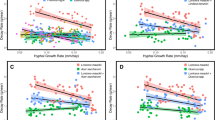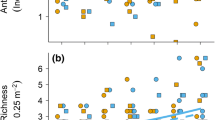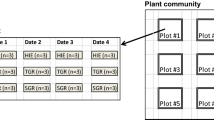Abstract
Exotic invasive shrubs can form dense monocultures in forest understories, which can have cascading effects on ecosystem structure and function. Amur honeysuckle, an exotic shrub that forms dense canopies in eastern forests, has the potential to alter plant community structure and ecosystem functions, such as primary production and decomposition. The goal of this study was to examine foliar productivity and leaf litter decomposition in forests invaded by Amur honeysuckle (Lonicera maackii) and to determine the extent to which the presence of this dominant exotic species may alter ecosystem function in these forests. We found that forests invaded by Amur honeysuckle had 16 times greater honeysuckle foliar biomass and 1.5 times lower total foliar biomass than forests of equivalent tree basal area, but having few honeysuckle shrubs. This suggests that productivity of native tree and shrub species may be reduced where honeysuckle density is high. Additionally, honeysuckle litter decayed four times faster and released nitrogen more rapidly than sugar maple litter, and sugar maple litter decayed 19% faster in forests invaded by Amur honeysuckle. These findings suggest that forests invaded by Amur honeysuckle may exhibit lower rates of organic matter accrual and less nitrogen retention in the forest floor. Since honeysuckle leaves develop in early spring before those of other shrubs or trees in the area, the rapid release of nitrogen from honeysuckle litter that we measured in early spring is timed to benefit this invasive species. The temporally coincident phenologies of nitrogen release during decomposition with the foliar growth needs of this shrub indicates that a potential positive feedback loop may exist between these processes that promotes continued growth and dominance of honeysuckle shrubs in these forested systems.







Similar content being viewed by others
References
Aber JD, Melillo JM (1980) Litter decomposition: measuring relative contributions of organic matter and nitrogen to forest soils. Can J Bot 58:416–421
Aber JD, Melillo JM (1991) Terrestrial ecosystems. Saunders College Publishing, US
Ashton IW, Hyatt LA, Howe KM, Gurevitch J, Lerdau MT (2005) Invasive species accelerate decomposition and litter nitrogen loss in a mixed deciduous forest. Ecol Appl 15(4):1263–1272
Bååth E (1989) Effects of heavy metals in soil on microbial processes and populations (a review). Water Air Soil Pollut 47:335–379
Berg B, Laskowski R (2006) Litter fall. Adv Ecol Res 38:19–71
Blair JM (1988) Nitrogen, sulfur, phosphorus dynamics in decomposing deciduous leaf litter in the southern Appalachians. Soil Biol Biochem 20(5):693–701
Botkin DB, Beveridge CE (1997) Cities as environments. Urban Ecosyst 1:3–19
Carreiro MM, Sinsabaugh RL, Repert DA, Parkhurst DF (2000) Microbial enzyme shifts explain litter decay responses to simulated nitrogen deposition. Ecology 81(9):2359–2365
Carreiro MM, Pouyat RV, Tripler CE, Zhu W-X (2009) Carbon and nitrogen cycling in soils of remnant forests along urban-rural gradients: case studies in the New York metropolitan area and Louisville, Kentucky. In: McDonnell MJ, Hahs AK, Breuste JH (eds) Ecology of cities and towns: a comparative approach. Cambridge University Press, New York
Chapin FS III, Matson PA, Mooney HA (2002) Principles of terrestrial ecosystem ecology. Springer, New York
Collier MH, Vankat JL, Hughes MR (2002) Diminished plant richness and abundance below Lonicera maackii, an invasive shrub. Am Midl Nat 147:60–71
Cotrufo MF, DeSanto AV, Alfani A, Bartoli G, DeCristofaro A (1995) Effects of urban heavy metal pollution on organic matter decomposition in Quercus ilex L. woods. Environ Pollut 89:81–87
Dorning M, Cipollini D (2006) Leaf and root extracts of the invasive shrub, Lonicera maackii, inhibit seed germination of three herbs with no autotoxic effects. Plant Ecol 184:287–296
Ehrenfeld JG (2003) Effects of exotic plant invasions on soil nutrient cycling processes. Ecosystems 6:503–523
Ehrenfeld JG, Kourtev P, Huang W (2001) Changes in soil functions following invasions of exotic understory plants in deciduous forests. Ecol Appl 11(5):1287–1300
Gatz DF (1991) Urban precipitation chemistry: a review and synthesis. Atmos Environ 25B:1–15
Gorchov DL, Trisel DE (2003) Competitive effects of the invasive shrub, Lonicera maackii (Rupr.) Herder (Caprifoliaceae), on the growth and survival of native tree seedlings. Plant Ecol 166:12–24
Harrington RA, Brown BJ, Reich PB (1989) Ecophysiology of exotic and native shrubs in Southern Wisconsin: I. Relationship of leaf characteristics, resource availability, and phenology to seasonal patterns of carbon gain. Oecologia 80:356–367
Hartman KM, McCarthy BC (2007) A dendro-ecological study of forest overstorey productivity following the invasion of the non-indigenous shrub Lonicera maackii. Appl Veg Sci 10:3–14
Hartman KM, McCarthy BC (2008) Changes in forest structure and species composition following invasion by a non-indigenous shrub, Amur honeysuckle (Lonicera maackii). J Torrey Bot Soc 135(2):245–259
Hobbie SE (1992) Effects of plant species on nutrient cycling. TREE 7(10):336–339
Hooper DU, Chapin FS III, Ewel JJ, Hector A, Inchausti P, Lavorel S, Lawton JH, Lodge DM, Loreau M, Naeem S, Schmid B, Setala H, Symstad AJ, Vandermeer J, Wardle DA (2005) Effects of biodiversity on ecosystem functioning: a consensus of current knowledge. Ecol Monogr 75(1):3–35
Hutchinson TF, Vankat JL (1997) Invasibility and effects of Amur honeysuckle in southwestern Ohio forests. Conserv Biol 11(5):1117–1124
Lovett GM, Traynor MM, Pouyat RV, Carreiro MM, Zhu W, Baxter JW (2000) Atmospheric deposition to oak forests along an urban-rural gradient. Environ Sci Technol 34(20):4294–4300
Lovett GM, Canham CD, Arthur MA, Weathers KC, Fitzhugh RD (2006) Forest ecosystem responses to exotic pests and pathogens in eastern North America. Bioscience 56(5):395–405
Luken JO, Goessling N (1995) Seedling distribution and potential persistence of the exotic shrub Lonicera maackii in fragmented forests. Am Midl Nat 133:124–130
Luken JO, Thieret JW (1996) Amur honeysuckle, its fall from grace. Lessons from the introduction and spread of a shrub species may guide future plant introductions. Bioscience 46(1):18–24
Luken JO, Kuddes LM, Tholemeier TC (1997) Response of understory species to gap formation and soil disturbance in Lonicera maackii thickets. Restor Ecol 5(3):229–235
Matson M, McClain EP, McGinnis DF Jr, Pritchard JA (1978) Satellite detection of urban heat islands. Mon Weather Rev 106:1725–1734
McEwan RW, Birchfield MK, Schoergendorfer A, Arthur MA (2009) Leaf phenology and freeze tolerance of the invasive shrub Amur honeysuckle and potential native competitors. J Torrey Bot Soc 136(2):212–220
Medley KE (1997) Distribution of the non-native shrub Lonicera maackii in Kramer Woods, Ohio. Phys Geogr 18(1):18–36
Melillo JM, Aber JD, Linkins AE, Ricca A, Fry B, Nadelhoffer KJ (1989) Carbon and nitrogen dynamics along the decay continuum: plant litter to soil organic matter. Plant Soil 115:189–198
National Atmospheric Deposition Program (NADP) (2010) Annual data for site: KY19 (Seneca Park). NADP program office, Champaign. http://nadp.sws.uiuc.edu
National Climatic Data Center (NCDC) (2009) NOAA satellite and information service. http://www.ncdc.noaa.gov/oa/ncdc.html. Page last modified. 26 Aug 2009
Oke TR (1973) City size and the urban heat island. Atmos Environ 7:769–779
Pavao-Zuckerman MA, Coleman DC (2005) Decomposition of chestnut oak (Quercus prinus) leaves and nitrogen mineralization in an urban environment. Biol Fertil Soils 41:343–349
Pouyat RV, Carreiro MM (2003) Controls on mass loss and nitrogen dynamics of oak leaf litter along an urban-rural land-use gradient. Oecologia 135:288–298
Pouyat RV, McDonnell MJ, Pickett STA (1997) Litter decomposition and nitrogen mineralization in oak stands along an urban-rural land use gradient. Urban Ecosyst 1:117–131
Swift MJ, Heal OW, Anderson JM (1979) Decomposition in terrestrial ecosystems. Studies in ecology, vol 5. University of California Press, Berkeley
The National Atlas of the United States (2009) http://www.nationalatlas.gov/mld/ecoomrp.html. Page last modified. 17 Sep 2009
Trammell TLE (2010) The forgotten forest: ecosystem structure, function, and services of forested verges along interstates in Louisville, KY. PhD dissertation, University of Louisville, Louisville, 241 pp
Trammell TLE, Carreiro MM (2011) Vegetation composition and structure of woody plant communities along urban interstate corridors in Louisville, KY, U.S.A. Urban Ecosyst. doi:10.1007/s11252-011-0193-4
Trammell TLE, Schneid BP, Carreiro MM (2011) Forest soils adjacent to urban interstates: Soil physical and chemical properties, heavy metals, disturbance legacies, and relationships with woody vegetation. Urban Ecosyst. doi:10.1007/s11252-011-0194-3
Trisel DE (1997) The invasive shrub, Lonicera maackii (Rupr.) Herder (Caprifoliaceae): factors contributing to its success and its effect on native species. PhD dissertation, Miami University, Oxford, 213 pp
US Census Bureau (2008) The 2009 Statistical abstract. http://www.census.gov/compendia/statab/cats/population.html. Page last modified. 24 Mar 2009
Van Soest PJ, Robertson JB, Lewis BA (1991) Methods for dietary fiber, neutral detergent fiber, and nonstarch polysaccharides in relation to animal nutrition. J Dairy Sci 74:3583–3597
Vitousek PM, D′Antonio CM, Loope LL, Rejmánek M, Westbrooks R (1997) Introduced species: a significant component of human-caused global change. NZ J Ecol 21:1–16
Webster CR, Jenkins MA, Jose S (2006) Woody invaders and the challenges they pose to forest ecosystems in the eastern United States. J For 104(7):366–374
Westendorf KL, Leuthart CA, Howarth DA (1989) A preliminary assessment of the Louisville urban heat island. Trans Ky Acad Sci 50(1–2):86–93
Zipperer WC, Guntenspergen GR (2009) Vegetation composition and structure of forest patches along urban-rural gradients. In: McDonnell MJ, Hahs AK, Breuste JH (eds) Ecology of cities and towns: a comparative approach. Cambridge University Press, New York
Acknowledgments
We thank Brad Schneid and Anthony Rietl for field and lab assistance during this research. We also thank Cary Cassell, Kentucky Transportation Cabinet (KYTC), for his guidance on conducting highway research safely, the Department of Highways, KYTC for permission to access the interstate rights-of-way, and the Louisville Metro Parks for permission to conduct research in Cherokee, Seneca, and Thurman-Hutchins Parks. For funding, we thank the Kentucky Academy of Science, the Kentucky Society of Natural History, the USDA Forest Service NRS-4952, the University of Louisville Research Foundation Intramural Research Incentive Grant, and the University of Louisville Summer Research Opportunity Program (support for H. Ralston).
Author information
Authors and Affiliations
Corresponding author
Rights and permissions
About this article
Cite this article
Trammell, T.L.E., Ralston, H.A., Scroggins, S.A. et al. Foliar production and decomposition rates in urban forests invaded by the exotic invasive shrub, Lonicera maackii . Biol Invasions 14, 529–545 (2012). https://doi.org/10.1007/s10530-011-0093-9
Received:
Accepted:
Published:
Issue Date:
DOI: https://doi.org/10.1007/s10530-011-0093-9




